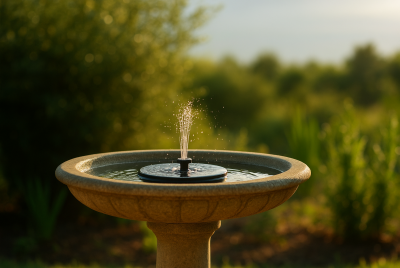Solar Power for Well Pumps: A Comprehensive Guide
It’s one of the best decisions you can make if you’ve ever thought about moving your well pump to solar electricity. In addition to lowering your electricity costs, it gives you a great sense of independence by giving you control over your water supply. Not only solar power for well pump environmentally benign, but they also promote independence and a forward-thinking mindset. Let’s examine the specifics so you can see how solar can help you win.
What Is a Solar-Powered Well Pump?
Imagine a pump that brings fresh water to your house, farm, or garden while the sun shines down. In essence, a solar-powered well pump accomplishes that. It does all the hard lifting using sunlight rather than a noisy, fuel-guzzling generator or the grid. For anyone wishing to power their property in a remote area, live responsibly, or save money, this sleek, contemporary solution is ideal. You’ll question why you didn’t switch sooner after you realize how it operates, I promise.
How Does a Solar Well Pump Work?
The great thing is that solar well pumps are a flawless example of how technology and nature can work together. The pump is powered by the electricity generated by solar panels that absorb sunlight. Depending on how it is configured, the system may have a battery to store additional energy for use at night or on overcast days. The finest aspect? Rain or shine—well, primarily shine—it simply keeps operating and is smooth and effective.
Benefits of Solar Power for Well Pumps
Let’s talk perks. First off, you’re tapping into a completely renewable energy source—hello, sustainability! Then there’s the freedom of being off-grid, which means you don’t have to stress about blackouts or rising electricity costs. And let’s not forget the low-maintenance aspect. Once it’s set up, a solar-powered well pump pretty much takes care of itself. Plus, it feels good knowing you’re making a positive impact on the planet.
Types of Solar Well Pumps
Not all solar well pumps are created equal, so it’s important to pick the right one for your needs. Submersible pumps are your go-to if you’ve got a deep well—they can handle depths of up to 400 feet without breaking a sweat. On the other hand, surface pumps are better for shallow wells, like those under 25 feet. And then there’s the question of power: DC pumps are more efficient because they work directly with solar energy, while AC pumps need an inverter. Each type has its sweet spot, so choose wisely.
Choosing the Right Solar Well Pump
Picking the perfect pump isn’t rocket science, but it does take a little thought. Start by figuring out how deep your well is and how much water you’ll need daily. Then, consider how much sunlight your area gets—lots of sunny days? You’re golden. Oh, and don’t forget your budget. Solar well pumps aren’t cheap upfront, but they’ll save you tons in the long run. It’s all about balancing what you need with what you can afford.
Components of a Solar Well Pump System
A solar-powered well pump system is like a team, and every part plays a key role. The solar panels are the star players, capturing sunlight and converting it into energy. The controller is like the coach, managing the energy flow and making sure nothing gets overloaded. The pump, of course, does the heavy lifting by pulling water from the ground. And if you add a battery to the mix, you’ve got a solid bench to keep things running when the sun’s not around.
Installation of a Solar Well Pump System
Setting up a solar well pump isn’t as daunting as it sounds. First, you’ll want to scout the best spot for your solar panels, ideally somewhere with lots of direct sunlight. Then, it’s time to assemble the system—panels, pump, controller, and optional battery. Once everything’s connected, you’ll run a few tests to make sure it’s all working smoothly. Finally, secure the setup so it can withstand weather and critters. Done right, it’s a one-time effort that pays off for years.
Maximizing Efficiency in Solar Well Pumps
Getting the most out of your solar well pump is all about the little things. Keep your panels clean—dust and dirt are efficiency killers. Make sure nothing’s casting shade on them, whether it’s a tree branch or a building. And if you’re really serious about performance, invest in high-quality parts from the get-go. Think of it like keeping your car in top shape: regular care equals better mileage.
Solar Well Pumps for Off-Grid Living
Living off the grid sounds dreamy, doesn’t it? No more reliance on traditional utilities, just you and nature doing your thing. A solar-powered well pump is a cornerstone of that lifestyle. It gives you water whenever you need it without worrying about grid outages or fuel supplies. Whether you’re in a remote cabin or running a small farm, it’s the kind of freedom that’s hard to put a price on.
Cost of Solar Well Pump Systems
Let’s be real—solar well pumps aren’t cheap. Depending on your setup, you’re looking at anywhere from $2,000 to $6,000 upfront. But here’s the kicker: once it’s installed, your operating costs are next to nothing. No electricity bills, no fuel expenses, just free energy from the sun. Over time, the savings pile up, making that initial investment feel like a steal.
Addressing Concerns About Solar Well Pumps
Got questions? You’re not alone. One common worry is cloudy days, but most systems come with batteries or generators to keep things running. Another concern is durability, and here’s the good news: a well-maintained solar pump can last over a decade. With proper care, these systems are as reliable as they come, giving you one less thing to stress about.
Maintenance of Solar Well Pumps
Taking care of your solar well pump is a breeze. Give the panels a quick clean every now and then to keep them soaking up maximum sunlight. Check the wiring and pump for wear and tear—you don’t want any surprises. And if your system has a controller, keep an eye on it for error messages. A little TLC goes a long way in keeping everything running smoothly.
Applications of Solar Well Pumps
The uses for solar well pumps are practically endless. Farmers love them for reliable irrigation, while homeowners appreciate the steady water supply for everyday needs. They’re also lifesavers in disaster situations, providing water when traditional systems fail. And let’s not forget livestock—your animals will thank you for the dependable hydration.
Solar Well Pumps vs. Traditional Systems
When you stack solar well pumps against traditional ones, solar wins in just about every category. Sure, the initial costs are higher, but you save big on energy bills and maintenance. Plus, you’re not tied to the grid, which means fewer headaches during power outages. And let’s not overlook the environmental benefits—solar is clean, green, and endlessly renewable.
Future of Solar Well Pumps
The future’s looking bright for solar well pumps—pun intended. Advances in technology are making them more efficient, more reliable, and more affordable. Think smarter controllers, better batteries, and higher-efficiency panels. As solar tech continues to improve, it’s only a matter of time before these systems become the go-to choice for water pumping.
Importance and Efficiency of Solar-Powered Well Pumps: Insights from Research
Scientific studies have highlighted the growing importance and efficiency of solar-powered well pumps in sustainable water management. A study published in the International Research Journal of Advanced Engineering and Science examined the performance of these systems, focusing on solar irradiance and its impact on micro-electric diaphragm pumps. The findings confirmed that solar-powered pumps effectively meet water supply needs, especially in sun-rich regions. Similarly, research in the Journal of Current Research on Engineering, Science and Technology emphasized the critical role of solar pumps for deep wells. It explored strategies to enhance efficiency, such as optimizing panel inclination and system design, underscoring the transformative potential of solar technology in remote and rural areas.
Related Solar-Powered Well Pump Products on Amazon
When considering a solar-powered well pump setup, exploring complementary products can enhance your system’s performance and reliability. Below are a few highly-rated options available on Amazon that you can check out:
ECO-WORTHY Solar Well Pump Kit
The ECO-WORTHY Solar Well Pump Kit is an all-in-one solution ideal for small to medium water needs. It includes a 24V submersible pump, solar panels, and a controller. Designed for remote areas, this kit offers simplicity and durability with its easy installation process.
The VEVOR Solar Water Pump System is a high-efficiency, deep well submersible pump. With a powerful motor and robust stainless steel construction, this product is perfect for those needing water from greater depths. It works seamlessly with solar panels for reliable performance.
To maximize your system’s efficiency, the Renogy 100 Watt Solar Panel is an excellent addition. These panels are highly durable and weather-resistant, ensuring optimal energy capture even in challenging conditions. Pairing these with your pump enhances performance and reliability.
EPEVER MPPT Solar Charge Controller
The EPEVER MPPT Solar Charge Controller helps regulate and optimize energy flow from your solar panels to the pump. This device prevents overcharging and extends the lifespan of your batteries, ensuring uninterrupted water supply even during low sunlight conditions.
FAQs
1. Can I run a well pump solely on solar power?
Yes, with a well-designed system, solar can handle all your water pumping needs, even during cloudy days with battery storage.
2. How long do solar-powered well pumps last?
With proper care, they can last 10 to 15 years or more, making them a solid investment.
3. Are solar-powered well pumps suitable for deep wells?
Absolutely. Submersible pumps are built to handle deep wells with ease.
4. What is the average cost of installing a solar well pump?
You’re looking at $2,000 to $6,000 upfront, depending on the size and complexity of the system.
5. Do solar well pumps work on cloudy days?
Yes, most systems include batteries or backup generators to keep things running smoothly when the sun isn’t shining.
Switching to a solar-powered well pump isn’t just about saving money—it’s about embracing a smarter, more sustainable way of living. So why wait? The sun’s already doing its job. It’s time to let it work for you.




